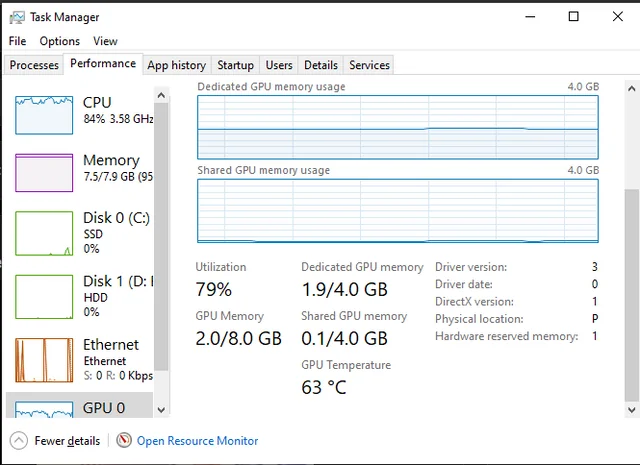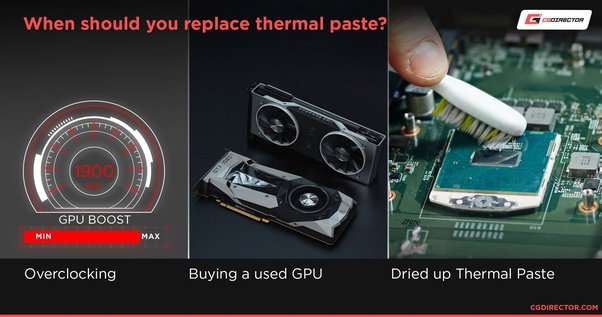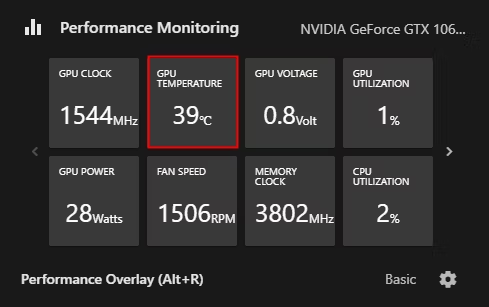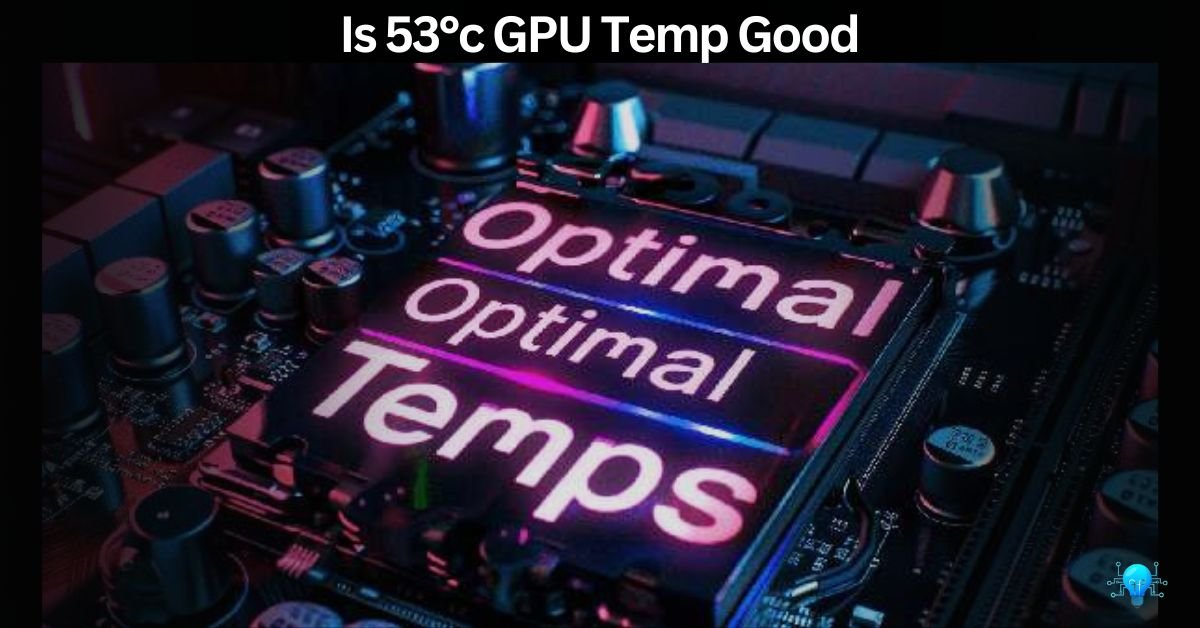I recently upgraded my PC cooling system, and now my GPU stays at a steady 53°C, even during intense gaming sessions. It’s a huge relief knowing my GPU is running cool and efficiently.
A GPU temperature of 53°C is very good. It indicates that your cooling system is effective, and your GPU is running efficiently without being under stress. This temperature helps ensure optimal performance and longevity.
Stay tuned with us as we discuss whether 53°C is a good GPU temperature. We’ll explain everything in simple terms so you can understand it easily.
Understanding GPU Temperatures:
GPUs can handle lots of different temperatures, but it’s important to keep them not too hot for good performance and lasting a long time. Usually, it’s safe for them to be between 60°C to 85°C when they’re working hard. If they get hotter than that, they might slow down to cool off. This can make your games run slower and your computer not as fast. Wondering how much GPU you should be using? Check out this guide for more info: How Much GPU Utilization Is Normal?

Is 53°C Good For A GPU?
A temperature of 53°C is generally considered excellent for a GPU. Here’s why:
Idle and Light Load Conditions: At idle or during light tasks such as web browsing or office work, a GPU temperature of 53°C is perfectly normal and indicates that the cooling system is functioning effectively.

Moderate Gaming or Workloads: During moderate gaming sessions or graphic-intensive workloads, maintaining a temperature around 53°C is very good. This suggests that your GPU has ample cooling and is not being excessively strained.
Thermal Headroom: A GPU running at 53°C has significant thermal headroom before reaching the higher end of its safe operating range. This means that even under increased load, the GPU can safely handle additional heat without throttling or risking damage.
Also Read: Can I Bring A GPU On A Plane? – 2024 Rules!
Benefits Of A Low Gpu Temperature:
- Improved performance: Lower temperatures can lead to increased overclocking headroom, allowing you to squeeze more performance out of your GPU.
- Increased lifespan: Running at lower temperatures can help extend the life of your GPU, reducing the risk of thermal-related failures.
- Reduced noise: Lower temperatures often result in quieter operation, as the cooling system doesn’t need to work as hard to keep the GPU cool.
Why Do GPU Temperatures Matter?
GPU temperatures are important because they affect how well your computer works. If your GPU gets too hot, it can slow down or even stop working. This can make your computer run slower, make loud noises, and even break.
High temperatures can also make your computer use more power, which can increase your electricity bill. Additionally, if your GPU gets too hot, it can reduce its lifespan and make it more prone to failure.
By keeping an eye on your GPU temperatures, you can help prevent these problems and keep your computer running smoothly and efficiently.
Do You Know? Do Both Monitors Need To Be Connected To The GPU? – My Strategy!
Factors Affecting GPU Temperatures:
Several factors influence the temperature of your GPU:
Cooling Solution: The type of cooling system (air, liquid, or custom cooling) significantly impacts GPU temperatures. Effective cooling solutions maintain lower temperatures.
Case Ventilation: Proper airflow within the PC case is essential. Good ventilation ensures that hot air is expelled and cool air is brought in, maintaining lower GPU temperatures.
Ambient Temperature: The temperature of the room or environment where your PC is located affects GPU temperature. A cooler room temperature helps in keeping the GPU cooler.
Workload: The intensity and nature of tasks being performed on the GPU impact its temperature. Gaming, video editing, and other demanding applications generate more heat compared to simple tasks.
How Can I Monitor My GPU Temperature?
You can monitor your GPU temperature using various software tools. Some popular options include MSI Afterburner, HWMonitor, GPU-Z, and CAM. These programs provide real-time temperature readings, as well as additional information about your GPU’s performance and usage.

Additionally, many graphics card manufacturers offer their own monitoring software, so you may want to check if your GPU’s manufacturer provides such a tool.
Read Also: Can I Use a CPU Cable For GPU? – Warning!
Tips To Maintain Optimal GPU Temperature:
If your GPU temperature is higher than 53°C, there are a few steps you can take:
- Regular Cleaning: Dust buildup can obstruct airflow and increase temperatures. Regularly clean your PC’s internals, especially the GPU and fans, to ensure efficient cooling.
- Improve Case Airflow: Ensure that your PC case has good airflow. Add or upgrade fans if necessary, and manage cables to prevent obstructions.
- Monitor Temperatures: Use software tools to monitor GPU temperatures. Programs like MSI Afterburner, HWMonitor, or GPU-Z provide real-time temperature readings.
- Adjust Fan Curves: Customize the GPU fan curves to increase fan speed as temperatures rise. This proactive approach helps in keeping the GPU cooler during intensive tasks.
- Consider Aftermarket Coolers: If your GPU runs hotter than desired, consider installing aftermarket cooling solutions designed for enhanced thermal performance.
Recent Post: Torch Is Not Able To Use GPU – A Troubleshooting Guide!
If My Gpu Is At 53°C, Should I Worry?
If your GPU is at 53°C, there’s generally no need to worry. This temperature falls within the safe operating range for most GPUs and indicates that your cooling system is doing its job effectively.
As long as your GPU stays around this temperature during regular use, you can expect it to perform well without any issues. For further information, you can also refer to this discussion on TechPowerUp forums: What is a safe GPU temperature?
Is 53° (Celsius) Bad For A Gpu While Gaming?
No, a temperature of 53°C is not bad for a GPU while gaming. In fact, it’s quite good and well within the safe operating range for most GPUs. During gaming, GPUs typically generate more heat due to the increased workload, so reaching 53°C is normal and indicates that your GPU is functioning efficiently.
As long as your GPU temperature stays below around 85°C under load, you can expect good performance without any issues. For more insights, you can also check out this discussion on Quora: Is 58 Celsius bad for a GPU while gaming?
Understanding Normal GPU Usage While Gaming:
Normal GPU usage while gaming varies depending on factors like game complexity and resolution. Typically, GPU usage can range from 60% to 100% during gaming sessions, with more demanding games pushing usage closer to maximum capacity. For a detailed understanding of normal GPU usage while gaming, I can refer you to this guide: What is Normal GPU Usage While Gaming?
My GPU 1070 Ti Is 53 Degrees When Idle. Is It Okay?
Yes, a GPU temperature of 53 degrees Celsius when idle is perfectly okay and normal for a GTX 1070 Ti. Idle temperatures can vary depending on factors like ambient temperature and your PC’s cooling setup, but 53°C is within the typical range for many GPUs, including the GTX 1070 Ti. If your CPU temperature reaches 80 degrees Celsius, you may want to check out this guide: Is 80 Degrees Celsius Hot For A GPU?
Can Ambient Room Temperature Affect My GPU Temperature?
Yes, ambient room temperature can affect your GPU temperature. A hotter room will make it harder for your GPU’s cooling system to dissipate heat, potentially causing your GPU to run hotter.
Conversely, a cooler room can help keep your GPU temperature lower. Therefore, it’s important to consider and manage the ambient temperature of your room to optimize your GPU’s performance and longevity.
Take Analysis To: My GPU Only Has 1 HDMI Port – Is It Good Or Not!
Is It Normal For GPU Temperatures To Fluctuate?
Yes, it’s normal for GPU temperatures to fluctuate. Fluctuations can occur due to changes in workload, ambient temperature, and cooling system efficiency. During idle or light usage, GPU temperatures may be lower, while they can rise during gaming or other intensive tasks. However, significant and sudden fluctuations may indicate issues with cooling or hardware, requiring further investigation.
Interesting Fact: What Happens When GPU Overheats – Don’t Wait Until It’s Too Late!
Frequently Asked Questions:
Is 53°C a safe temperature for my GPU?
Yes, 53°C is generally considered a safe temperature for most GPUs. It indicates efficient cooling and ensures that your GPU operates within its safe thermal limits, minimizing the risk of performance issues or damage.
Why is GPU temperature at 53°C considered good?
A GPU temperature of 53°C is considered good because it falls within the safe operating range for most GPUs. It indicates efficient cooling and ensures optimal performance without risking overheating.
Can software updates or driver changes affect GPU temperature readings?
Yes, software updates or driver changes can potentially affect GPU temperature readings. Sometimes, updated drivers may optimize GPU performance or adjust fan speeds, impacting temperature management.
Are there specific tasks where a GPU temperature of 53°C might not be ideal?
Yes, tasks that heavily stress the GPU, such as rendering complex 3D graphics or running demanding simulations, might push the temperature higher. However, 53°C is generally acceptable for most common tasks and moderate gaming.
What are some potential risks if my GPU temperature exceeds 53°C?
If your GPU temperature exceeds 53°C, there’s a risk of reduced performance, thermal throttling, and potentially even hardware damage over time. It’s essential to monitor temperatures and ensure proper cooling to mitigate these risks.
Conclusion:
A GPU temperature of 53°C (127°F) is considered good and within the safe zone. It indicates that your graphics card is operating within a comfortable temperature range, allowing for optimal performance and longevity.

